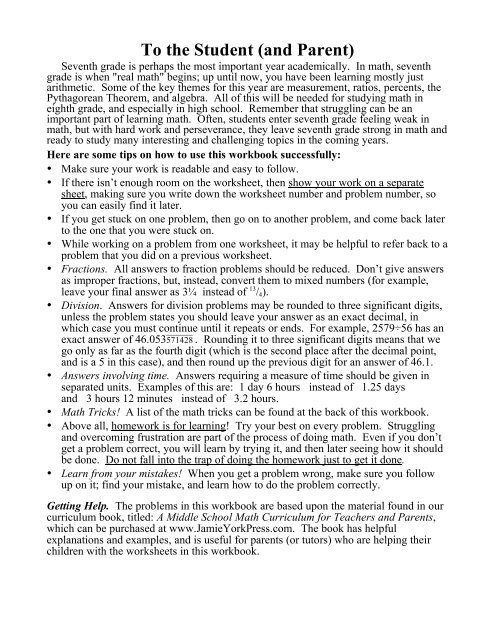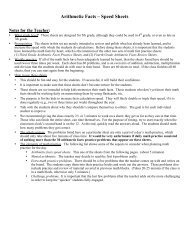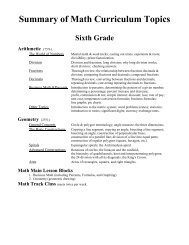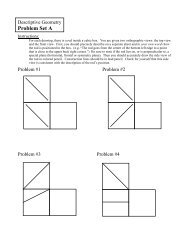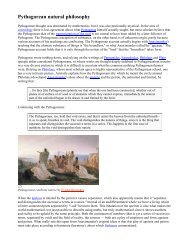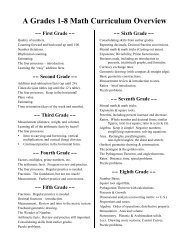7th Grade Student's Workbook Sample Pages - Jamie York Press
7th Grade Student's Workbook Sample Pages - Jamie York Press
7th Grade Student's Workbook Sample Pages - Jamie York Press
Create successful ePaper yourself
Turn your PDF publications into a flip-book with our unique Google optimized e-Paper software.
To the Student (and Parent)<br />
Seventh grade is perhaps the most important year academically. In math, seventh<br />
grade is when "real math" begins; up until now, you have been learning mostly just<br />
arithmetic. Some of the key themes for this year are measurement, ratios, percents, the<br />
Pythagorean Theorem, and algebra. All of this will be needed for studying math in<br />
eighth grade, and especially in high school. Remember that struggling can be an<br />
important part of learning math. Often, students enter seventh grade feeling weak in<br />
math, but with hard work and perseverance, they leave seventh grade strong in math and<br />
ready to study many interesting and challenging topics in the coming years.<br />
Here are some tips on how to use this workbook successfully:<br />
• Make sure your work is readable and easy to follow.<br />
• If there isn’t enough room on the worksheet, then show your work on a separate<br />
sheet, making sure you write down the worksheet number and problem number, so<br />
you can easily find it later.<br />
• If you get stuck on one problem, then go on to another problem, and come back later<br />
to the one that you were stuck on.<br />
• While working on a problem from one worksheet, it may be helpful to refer back to a<br />
problem that you did on a previous worksheet.<br />
• Fractions. All answers to fraction problems should be reduced. Don’t give answers<br />
as improper fractions, but, instead, convert them to mixed numbers (for example,<br />
leave your final answer as 3! instead of 13 / 4 ).<br />
• Division. Answers for division problems may be rounded to three significant digits,<br />
unless the problem states you should leave your answer as an exact decimal, in<br />
which case you must continue until it repeats or ends. For example, 2579÷56 has an<br />
exact answer of 46.053571428 """"" . Rounding it to three significant digits means that we<br />
go only as far as the fourth digit (which is the second place after the decimal point,<br />
and is a 5 in this case), and then round up the previous digit for an answer of 46.1.<br />
• Answers involving time. Answers requiring a measure of time should be given in<br />
separated units. Examples of this are: 1 day 6 hours instead of 1.25 days<br />
and 3 hours 12 minutes instead of 3.2 hours.<br />
• Math Tricks! A list of the math tricks can be found at the back of this workbook.<br />
• Above all, homework is for learning! Try your best on every problem. Struggling<br />
and overcoming frustration are part of the process of doing math. Even if you don’t<br />
get a problem correct, you will learn by trying it, and then later seeing how it should<br />
be done. Do not fall into the trap of doing the homework just to get it done.<br />
• Learn from your mistakes! When you get a problem wrong, make sure you follow<br />
up on it; find your mistake, and learn how to do the problem correctly.<br />
Getting Help. The problems in this workbook are based upon the material found in our<br />
curriculum book, titled: A Middle School Math Curriculum for Teachers and Parents,<br />
which can be purchased at www.<strong>Jamie</strong><strong>York</strong><strong>Press</strong>.com. The book has helpful<br />
explanations and examples, and is useful for parents (or tutors) who are helping their<br />
children with the worksheets in this workbook.
Arithmetic ! Sheet #1<br />
Quickly Estimate.<br />
Do it in your head<br />
21) What is half of 7 13 ?<br />
1) 400 · 3000<br />
22) 485,036 + 225,672<br />
2) 8.46 ÷ 100<br />
3) 8.46 · 1000<br />
23) 7364 · 587<br />
4) 49 · 11<br />
24) 55,963 # 42,027<br />
5) 42000 ÷ 600<br />
6) 3.5 · 4<br />
25) 5273 ÷ 886<br />
7) 105 · 108<br />
8) 512 # 497<br />
Division. Leave your<br />
answers as exact decimals<br />
9) 3 · 999<br />
(perhaps repeating). Use short<br />
division for single digit<br />
10) 24 · 99<br />
11) 3.6 · 5<br />
divisors.<br />
26) 25,286 ÷ 47<br />
12) 3.6 ÷ 5<br />
13) 27 # 3.7<br />
14) 0.3 · 0.008<br />
15) 0.4 ÷ 0.008<br />
16) 13 2<br />
17) 25 · 6<br />
18) 3 4<br />
19) 5 3<br />
20) What is half of 8 13 ?<br />
27) 4277 ÷ 25<br />
28) 0.0073 ÷ 0.06<br />
29) 7809 ÷ 1.37<br />
- 2 -
5<br />
Fractions & Decimals 33)<br />
6 + 2 40) 48.3 + 1.24<br />
5<br />
30) Convert fractions to<br />
decimals and decimals to<br />
fractions.<br />
a) 93<br />
100<br />
48<br />
34)<br />
49 · 35<br />
41) 48.3 # 1.24<br />
48<br />
9<br />
b)<br />
1000<br />
c) 3 5<br />
42) 48.3 · 1.24<br />
35) 5 3<br />
d) 5 5 · 13 7<br />
6<br />
e) 8 11<br />
36) 5 3<br />
f) 7 5 # 13 7<br />
24<br />
g) 0.07<br />
Powers & Roots<br />
43) (8) 2<br />
h) 0.043<br />
i) 0.55<br />
44) (800) 2<br />
37) 5 3 5 ÷ 13 7<br />
j) 0.3"<br />
45) (0.8) 2<br />
k) 0.875<br />
46) (0.008) 2<br />
5 3<br />
31) Convert to a mixed<br />
5<br />
38)<br />
number.<br />
1 3 47) (12) 3<br />
7<br />
45<br />
7<br />
48) (0.1) 5<br />
32) Convert to an<br />
improper fraction. 39) (2$) 2 49)<br />
6 4 64<br />
9<br />
50) 9000000<br />
- 3 -


